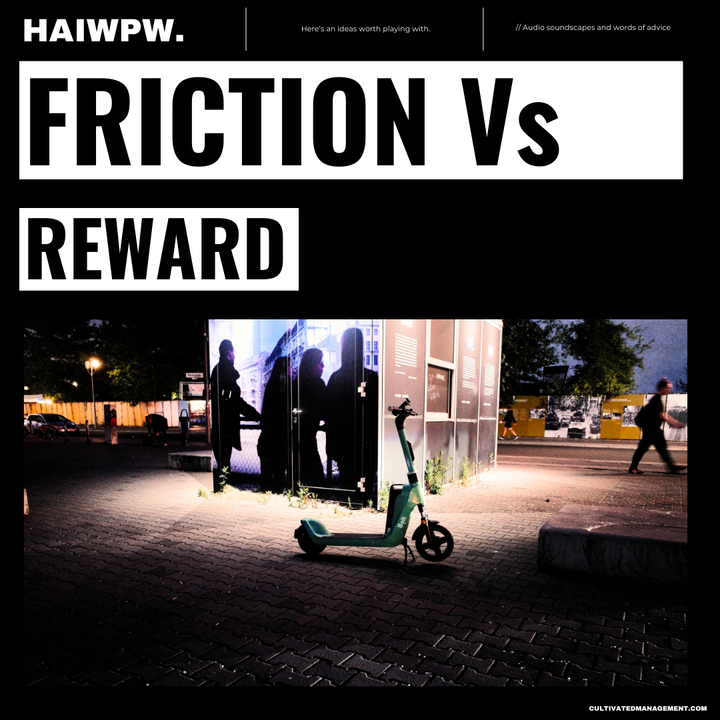Nash's use of Leisure Time pyramid - flawed but still helpful - podcast
In this episode and post, I share a leisure time model from the 1920s that is still helpful today - and how we can draw connections to employee engagement.
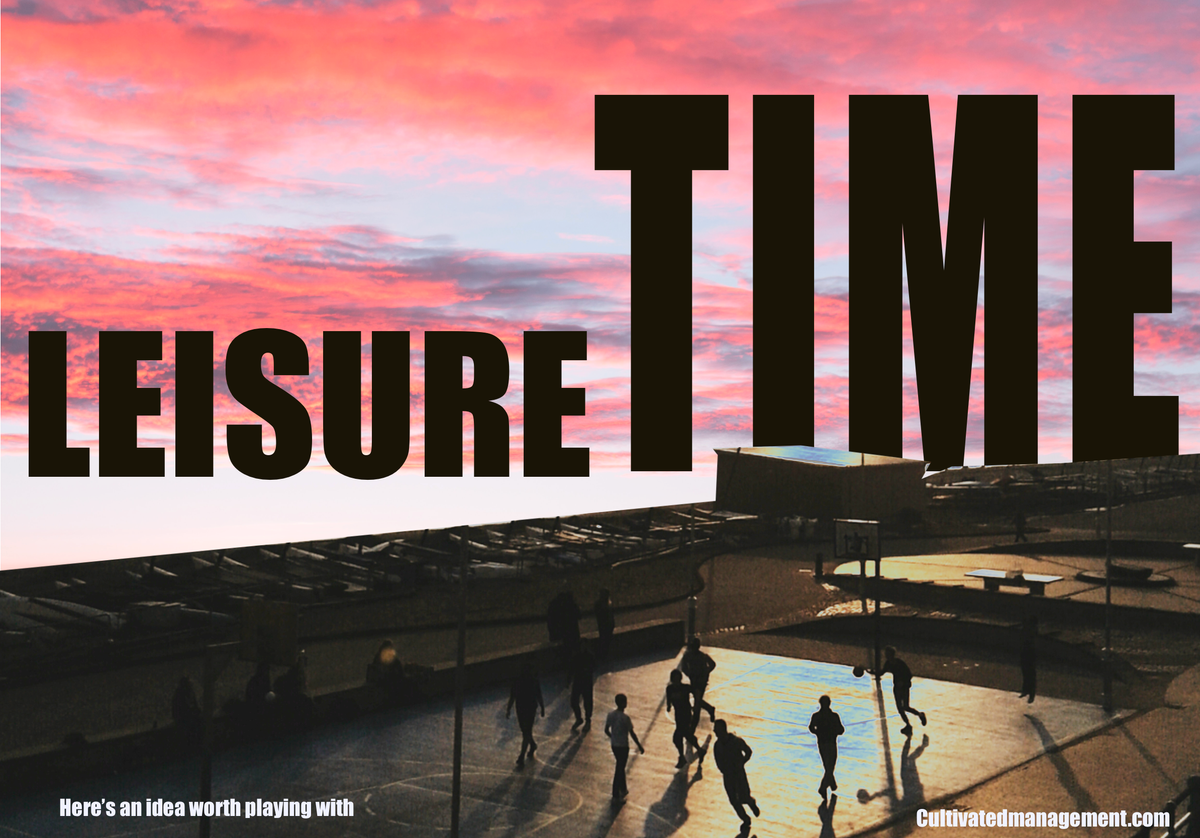
In today's cast and post I'm introducing a model of leisure time from the 1920's. It's called Nash's Leisure Time Pyramid.
It may be flawed, not overly scientific and have some strong critics, but I found it insightful for my own life - and of course, there are plenty of parallels to work - especially in the field of employee engagement (which you may know, I'm not a fan of).
I'll introduce the Netflix challenge (a dysfunctional game being played at a workplace) and explain how I draw connections to work from what is a sociology lifestyle model. I've also done some digital collages to accompany the episode which are in this post.
Some people get more leisure time than others. Some people maximise the use of their leisure time, maybe around the pillars of life, maybe just across a holistic mind, body and spirit. Some people have access, privilege, money, opportunities - and some people don't.
How we choose to use our leisure time is personal to us (assuming we don't invade the lives and privacy of others). And this is where models like Nash's "Leisure Time Pyramid" come in.
All models are wrong but some are more useful than others - and, despite its many flaws, Nash's model struck a chord with me.
Here is Nash's pyramid with my learning notes around it.
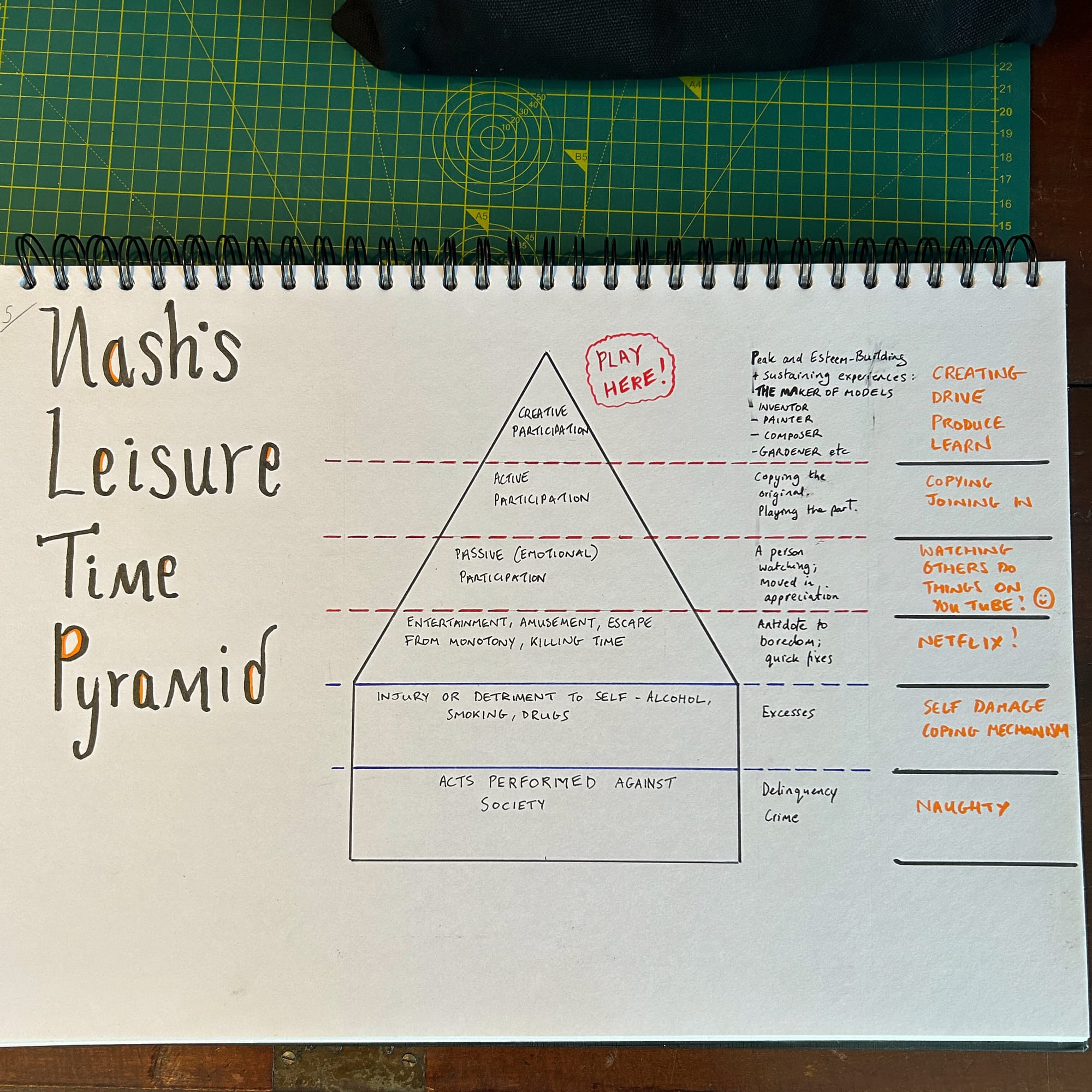
Here's the podcast. Artwork and transcript are below.
"Here's an idea worth playing with" is a regular podcast (and post) where I share ideas to help you make the business better. Not all of the ideas will be right for you - hence, it's an idea worth playing with.

Transcript
(Computer generated - edited after for typos and missing stuff)
Today, I'm gonna be talking about Nash's pyramid of leisure activities.
It's an old model. It's got some complications and it's got some criticisms but like all things here at Cultivated Management there's always a nugget of wisdom that we can learn from pretty much anything. That's the foundational thought that goes into much of my career, my work and hopefully the stuff that I share with you. We can learn from anything.
Now Nash's pyramid is an old one. We'll cover the pyramid itself and the essentially 6 different levels that sit within it.
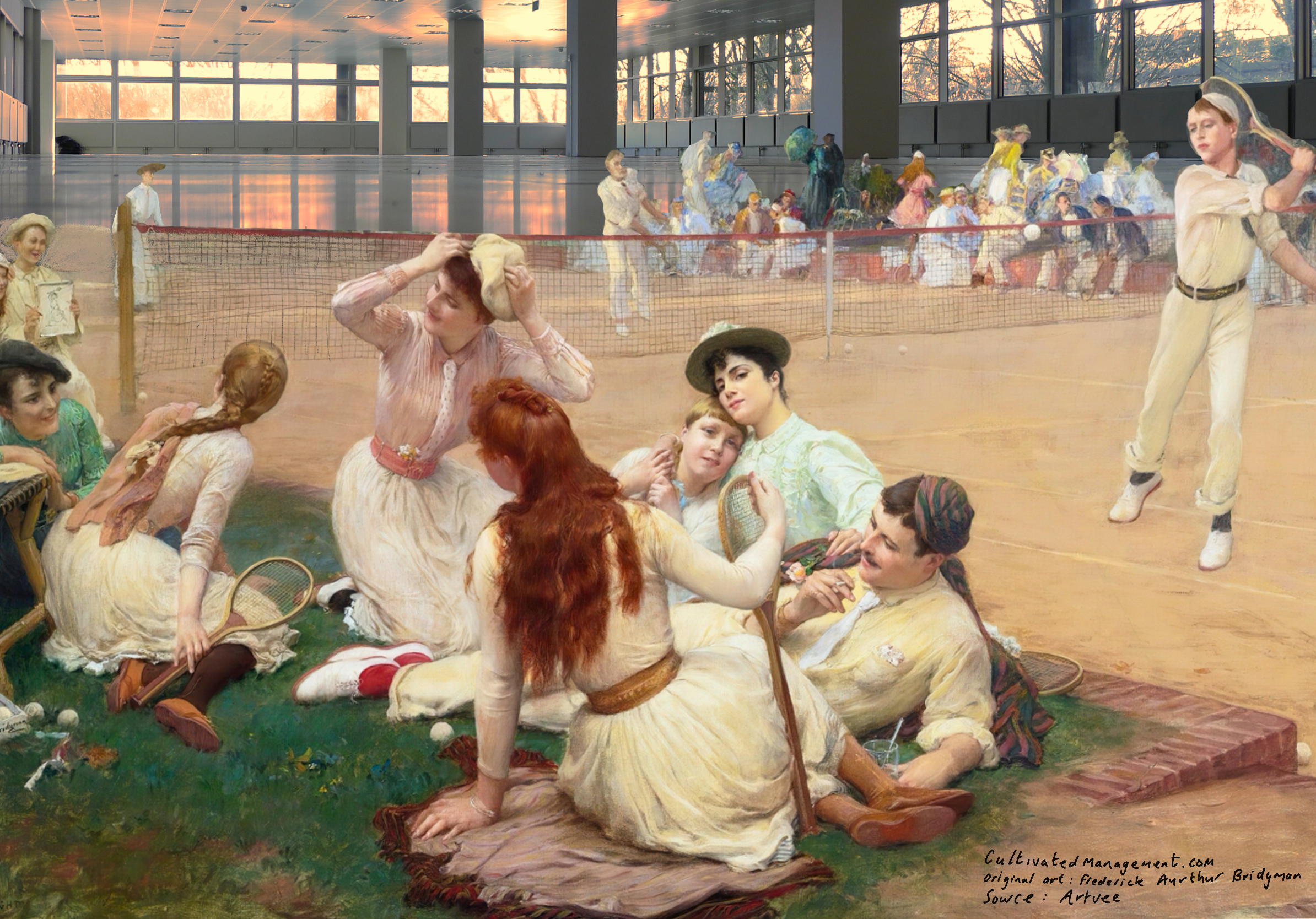
Now bear in mind this is a social construct, that we're gonna be talking about for society. But there's plenty that we can learn when we move this into the world of work. I'll talk about the Netflix challenge which was something that I encountered in one of my first consulting gigs and how that was detrimental to the business but also fits nicely into Nash's pyramid. Anyway, enough preamble, enough solo waffle, Let's get on with the show.
This was a pyramid that was designed by a gentleman called J B Nash. This was in about 19 twenties, I think. I can't find exactly the first time that this pyramid came to life so to speak. But I think it was in about 1920s. That's when it starts first being referenced.
J B Nash developed this as a way to think about society in a way that, you know, we could mobilise society to understand how society can get the best of their leisure time.
Now bear in mind, this was way back in the 1920s and we live in a very very different world now with the internet and phones. So actually I find this pyramid even more insightful now than maybe it was in the twenties.
We'll cover also some of the criticisms. So let me just take a moment to explain what the pyramid looks like. So if you imagine a straightforward triangle, the longest part of the triangle running, horizontally across the bottom and then obviously up to the peak on both sides. But sitting below the triangle is essentially a rectangle. There are 6 levels within this.
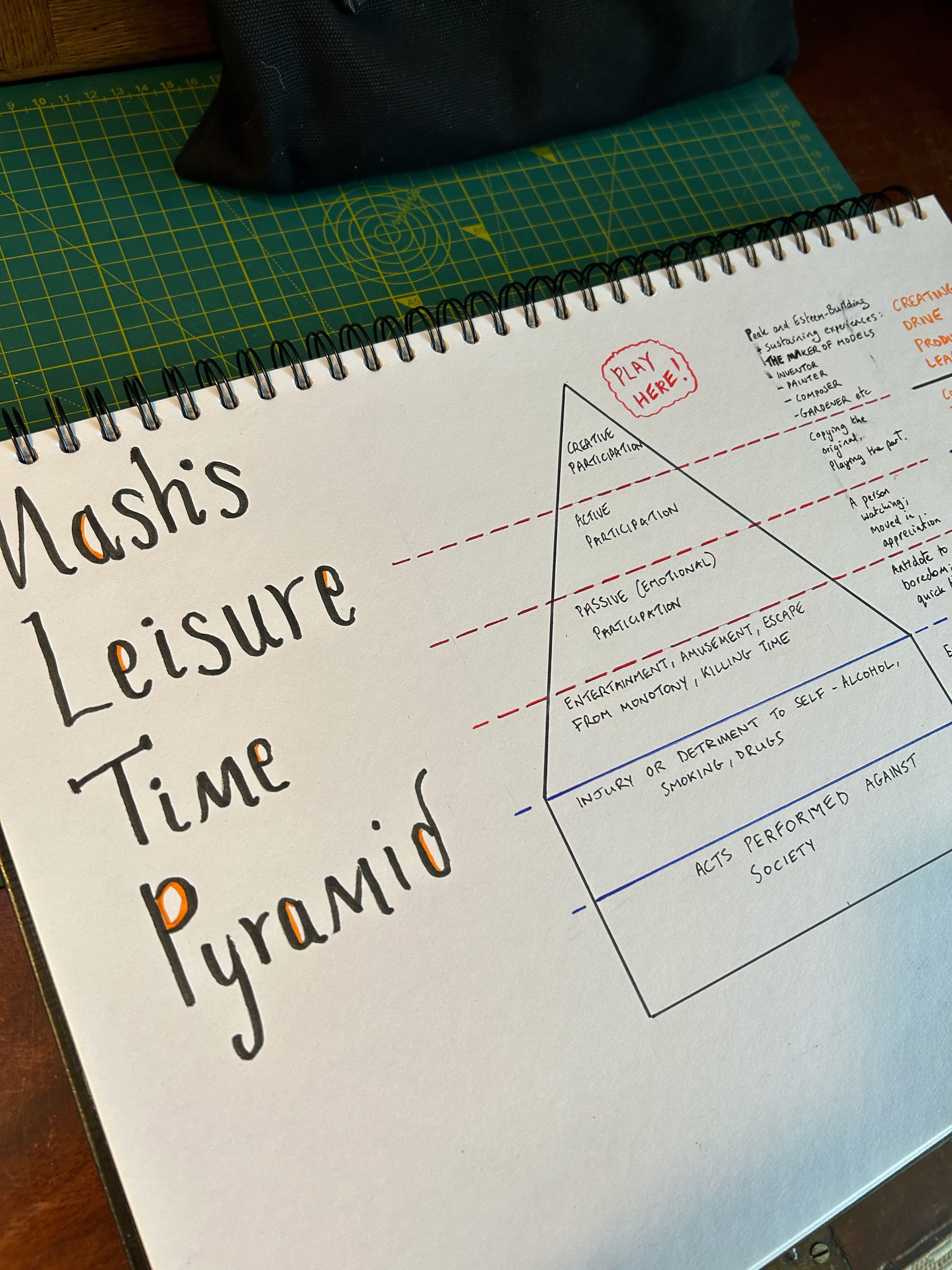
In the rectangle at the bottom below the pyramid there are 2. There's, subzero which is the very very bottom 1, then you've got zero.
Then you've got the bottom of the triangle starts forming, you've got the first level, then you've got another second, a third and a fourth.
So at zero he came up with this idea that you've got excesses.
Now this is essentially injury, it's detriment to yourself, I mean he describes alcohol, smoking, that kind of stuff. It's things that really aren't that good for you, you know, things that are detrimental to yourself.
Below that, you've got an element called subzero.
In subzero, he describes this as acts performed against society. So think crime, delinquency, antisocial behaviour, that kind of stuff. Now these are below zero. These are the sort of almost the unwanted elements of leisure time.
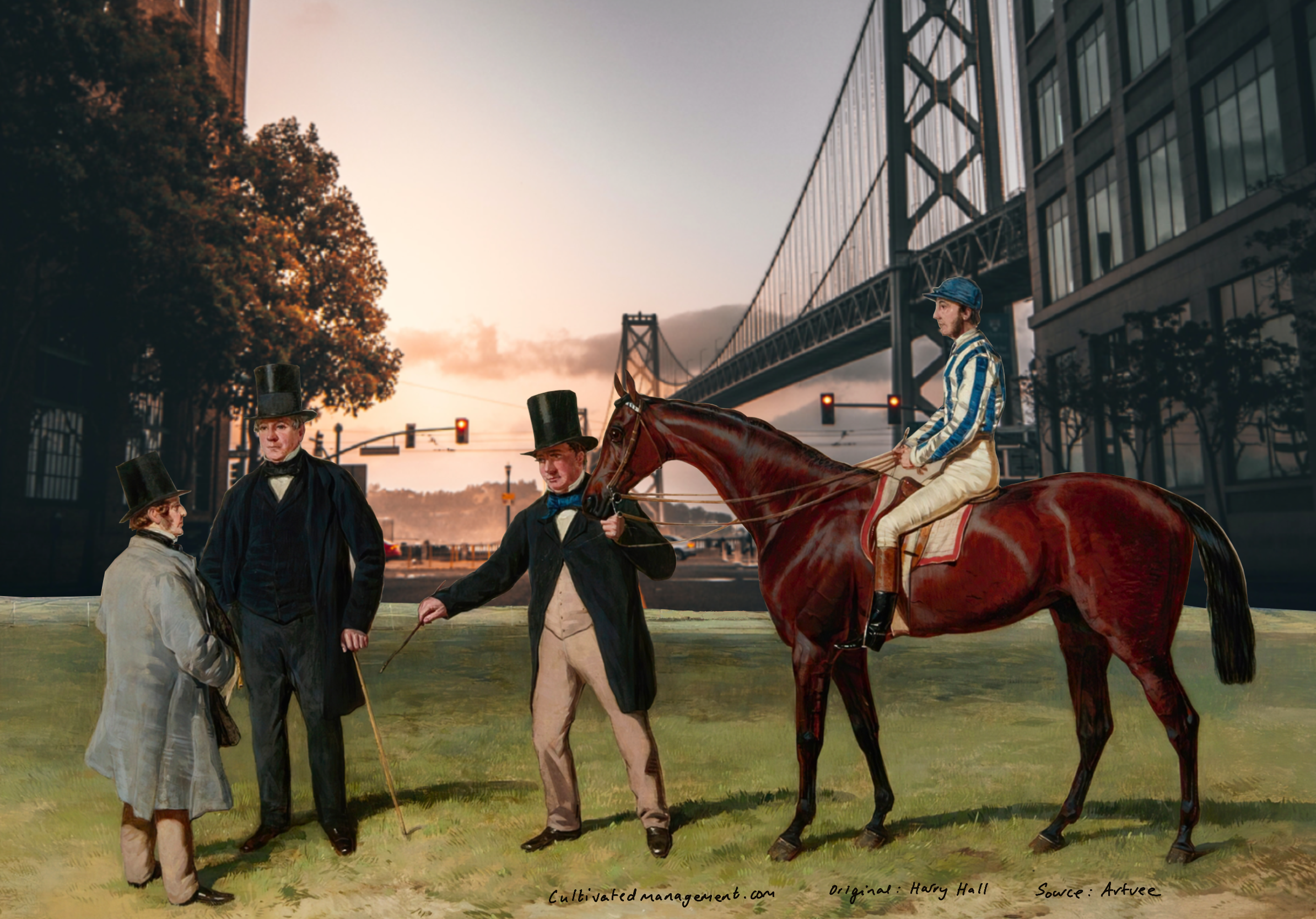
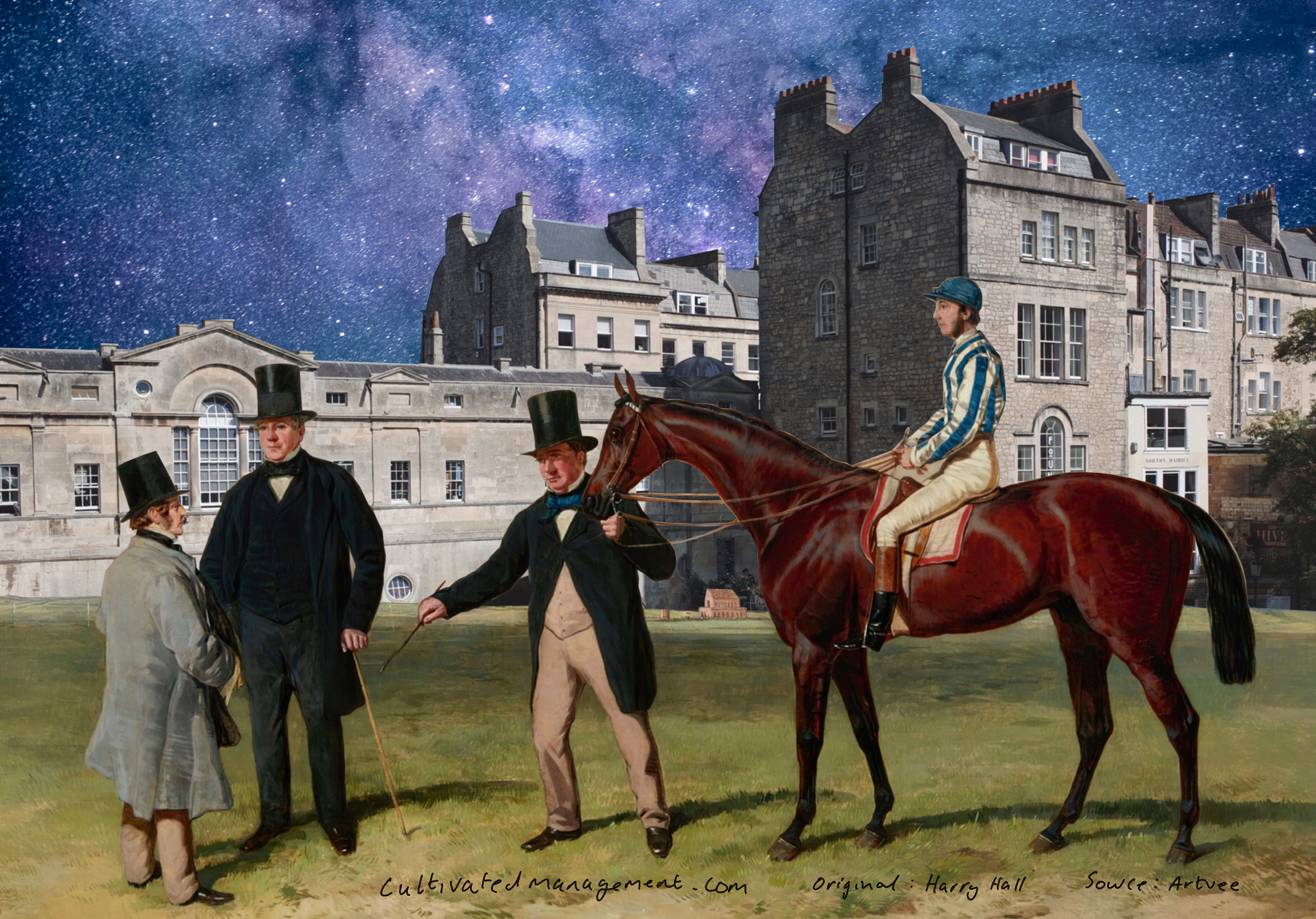
I couldn't decide which background looked better. The first with a cityscape, or the second with an image taken in Bath, England, which itself has star skies behind it. Original painting by Harry Hall on Artvee.
Obviously, we we we shouldn't want, people to be doing excessive type stuff and delinquency and crime. So that's why there's 0 and subzero.
So then we move above the line to number 1.
Now number 1 is the sort of basic widest part of the actual pyramid itself.
Nash describes this essentially as an antidote to boredom. This is quick fixes, you know, it's entertainment, it's amusement, it's, you know, watching TV. It's surfing the web. It's doom scrolling on Instagram. This is a kind of boredom quick fix.
You got nothing really, you know, educational, I guess, coming from this, although you could argue that you could get lots of educational entertainment from, TV. But this is really just about escaping monotony. It's just an escape. Now that's level 1. Now that's the biggest part of the pyramid.
And I think really what Nash was trying to argue here was that most people are in that stage. Now when I think about self, this is kind of, you know, watching Netflix. I'm bored, I'm distracted, I don't feel like doing anything, I'm just gonna put Netflix on. We'll come to the Netflix challenge in a minute.
At level 2, you've got passive emotional participation.
Now this is really somebody sort of almost watching somebody else do something of value. This is almost it describes it as move to appreciation. So you appreciate when you see somebody doing something amazing.
I spend a lot of time here I'll be honest and I probably need to lift myself up the pyramid if you agree with the pyramid structure. But I spend quite a lot of time, you know watching people on YouTube doing really cool stuff like you know maybe they're modifying a car or they're making some furniture out of some wood.
I love those kind of videos where you just you sort of you sort of just watch somebody making something, it's so bizarre. And you're sort of moved to appreciation, there's an acknowledgement that what that person's doing is valuable, it's a thing of beauty, it's a thing of interest, it's something that you can sit and watch but you're passive in this.
There's no active participation in this. I'm just passively consuming that content and I'm moved in appreciation. Now you could argue as well that this is sort of going to theater, it's going to the cinema, it's going to watch a band.
There's kind of a passiveness to it. You're there and you're enjoying it and you're involved in the audience but you're not doing the actual work, so to speak. And this is obviously a great use of leisure time, there's an opportunity to appreciate and I guess really study and observe somebody. There's a sort of passive consumption involved in this. It's a valuable use of leisure time.
And according to Nash that sits higher than, you know, the antidote to boredom, Netflix, watching TV, you know, doomscrolling, that kind of stuff.
So then you move to level 3.
This is active participation. So we're nearly at the top of the pyramid, not quite the top box but the one below it. This is active participation where you're copying the original as he describes it.
You're playing the part.
Now I see this as almost kind of like a ladder and it is in the pyramid, obviously, a step up from that passive participation watching somebody and appreciating what they do. I do this a lot so I subscribe to a learning platform called Domestika. I can sometimes just sit and watch learning videos on how to do all sorts of random stuff from, you know, paper craft to woodwork to, you know, marketing, any of these kind of things. And that's level 2.
That's passive emotional participation. I'm moved into appreciation. I'm understanding. I'm reading. Maybe I'm making a few notes as well, But I'm not doing anything.
I'm not active in the creation of anything there. So this level 3 that Nash is talking about is actually copying the original playing the part. So this is where I might watch a Domestika video on how to do stop motion animation, which is what I'm interested in at the moment, and then I go and actually make a stop motion animation.
I'm copying what's been told, and I'm doing it myself, and I'm creating something. It's not original, so to speak, because I'm sort of just following the process and I'm copying other people.
But it's useful. I'm getting something from it. There's something being created off the back of it.
Level 4 in Nash's, leisure time is is really about creative participation.
This is people who are making the things that other people are watching and copying.
They're the inventors, they're the people who are founding a company and leading it from the front as an entrepreneur. They're the painters, the composers, people out in their garden, you know, gardening, growing trees and plants and vegetables or fruit or whatever it is that you do. This is people who are creating things.
They're not copying what everyone else is doing. They're not sat there passively consuming, which would be the level 2, and they're definitely not killing time by sitting watching Netflix or, you know, doomscrolling on Instagram - Level 1.
They're actually out doing something. There's a creative participation here. It could be writing a book, it could be recording a podcast like this, this is a creative participation moment, a level 4 on the pyramid.
So they're the 6 levels.
You've got subzero, acts against society, you know, delinquency crime.
You've got zero, injury or detriment to yourself. You've got level 1 which is escape from monotony. This is killing time. Level 2 is passive participation. So that's kinda moved into appreciation by watching somebody else.
Level 3 is active participation. This is about copying other people, playing the part, being part of something but not necessarily creating that. And then number 4 you've got creative participation, the top of the pyramid.
I think really when you look at what Nash was trying to achieve with this he was in a sense articulating what the US society at the time was struggling with which is, society shifting and changing, you've got the introduction of different communication mediums and different ways to waste your time, so to speak. And his argument was really we wanna be moving up that pyramid.
When I first saw it I actually really resonated with it. And I'll tell you the story of the Netflix challenge.
The Netflix Challenge
So I joined a company, a very, very big company. You will absolutely definitely have heard of this organization. And I was brought in to coach the vice president of software engineering at the time.
After 2 or 3 days, I realized this guy's completely un-coachable. I mean, he was the reason why the business was not succeeding. Let's put it that way. He got moved sideways and I got to to take over which was brilliant. Great.
Loved it. Maybe he didn't appreciate that and he didn't like me for it, but I think it was the right thing.
After about a week of literally speaking to everyone in the team, I realized and discovered that about 50 percent of the software engineering team were playing this thing called the Netflix challenge.
What they were trying to do is basically watch as much Netflix as they possibly could whilst working from home and sometimes in the office before anybody would notice and call them out on it. They'd been doing this for months.
When they should have been doing code, writing software, building products, working with other people, they were essentially watching Netflix.
And they had a leaderboard and their leaderboard had the top 10, top 20 people. And also what they were watching, how much they were watching, and what their rating of that program was. It was a thing that they'd introduced because they were so disengaged. They were so utterly fed up and miserable.
They were sick and tired of the leadership. They had no real clarity over what they were doing. There was nobody bringing anybody together to align anything. And frankly, they were able to get away with it. There were no consequences for this.
So upon discovering it, I obviously put an end to this, you know, not necessarily reading them the riot book at all. In fact, actually, it was a very calm moment where I was like, no. I get it. I don't think it's very professional. Let's put it that way, there's some strong feedback there, but I understand why you did it and how you're allowed to get away with this and that's the system that you're working in. Let's put it that way.
But when we look at Nash's concept use of leisure time, what they were doing was, essentially an escape from monotony. They were killing time. They were bored.
They were quick fixes. They were at level 1 of the pyramid. They were burning their time watching Netflix. But when you look at that pyramid from the perspective of a company or somebody who might own a business, it was actually subzero. It was an act performed against the business.
It was a waste of business resources. They were getting paid to do something that they weren't doing and they were watching Netflix all day. It was an act performed against the business.
And when I look at Nash's concept use of leisure time and I look at it in terms of the business, I see some real interesting, correlations. And these are the bits that I pull from these models.
No matter how broken, no matter how much criticism some of these models might get, there are opportunities to learn. And when we look at level 4, right at the very top, creative participation, you absolutely need people in the organization who are inventing new ways of doing things. They are creating new products. They're creating new opportunities. They are creating new ways of working.
They are the maker of the model as Nash would call it. That's level 4. You need people in your organization like that. But you can't fill the organization with people participation. At level 3, you need people who are playing the part.
They are taking what the inventors and the creative participations at the top level at level 4, and they are actively participating in it. They're copying the original, they're playing the part, they're part of this way of working, they are all contributing their skills and experience and behaviors to building the product, to getting the thing shipped, to marketing or whatever it is that your line of work is. You need people at that level 3 playing the part.
Now level 2 is where it starts to get a bit sketchy and a little bit difficult to think about whether you'd need lots of people operate at this level at a business. They're kind of moved in appreciation of watching somebody.
Now I kind of think this is good. You know 1 thing that I've always tried to do is whenever anything is going really well somewhere is we don't take it apart, deconstruct it and force it across the organization. Instead, we gather people around and we point at it, and we shine a light on it, and we ask people to do demonstrations or talk about how they came up with this new way of working or this new product or this new thing. We shine a light on good work. And by shining a light on good work, you're hoping to trigger this this level 2, this passive emotional participation.
People are watching, they're learning, they're listening, and they're moved in appreciation. And by doing so they can then take that back and maybe they go to level 4 and they go back to their team and they create a new way of working based on what they've learned from somebody else. And then the cycle starts again where you get people around playing the part and hopefully you're gonna make the business better.
Level 1 in a business this is entertainment, amusing, killing time this is sort of basic level of the pyramid it's an antidote to boredom. And actually when you look at almost all employee engagement surveys you see a lot of this.
You see a lot of people who are kind of happy in work. I'm always sort of intrigued by the Blessing and White X-model of employee engagement. There's 1 quadrant which is why you have to be very very careful with employee engagement surveys, there's 1 quadrant of people who are called the honeymooners who are super happy. They actually really enjoy being at work.
They like the culture, they like the vibe, they like the business, they score highly on employee engagement surveys, but they're not adding any value to the business.
So if you rely solely on employee engagement surveys be very very careful because you might have people here who are escaping from monotony by playing the Netflix challenge.
If you can get away with that, if you can get away with bringing the bare minimum to the workplace and there's no consequences for it. You enjoy it. You like the people that you work with. It's a good use of your time. You're getting paid reasonably well but you're not adding any business value. Then why would you rock the boat if that's your kind of personality?
So you have to be very very careful about those with employee engagement surveys.
And I think a lot of people are going through this engagements dipping all over.
You've got quiet quitting. You've got the great resignation. You've got all of these things happening. And I think really people are just completely and utterly disengaged from work. And so I use something like Nash's concept of leisure time to think about at work, how can I help people if they want the help?
And if they don't want the help, then that's a different performance conversation.
But if they do want the help, how can we move them through a sort of a a work equivalent pyramid to Nash's concept? How can we get them to be more active participation, actually showing up, turning up, doing more than the bare minimum in their job and their role? How can we help them move into creative participation to think about how to make the business better, how to do something different, how to create something, innovate? You know, all of that kind of good stuff that businesses really want but actually businesses really struggle to, implement.
Now as we go through this journey on this here's an idea worth playing with podcast, I'm hoping to share with you lots and lots of different ways in which I've done this and what you can do as well if you're interested.
But Nash's model, I like it. It might be wrong, it might be of a time that we no longer live in, but there's elements that we can borrow from that so that we can think about how we can apply them to the modern world in which we find ourselves in. I would encourage you to go and read the Wikipedia page, that's a good start. There's lots of other reference on there and understand a bit more about this, concept of leisure time.
So in a nutshell, I like it. I think it's interesting. It's definitely flawed. Don't get me wrong. It's not amazingly scientific.
But there are lessons that we can pull across into work.
You know? Do we have people who are spending the majority of their time killing time, surfing the web, not doing the job, wandering around, playing the Netflix challenge? Do we have people who are passively participation? Have we given people opportunity to be moved in appreciation from somebody doing some great work?
Do we have a lot of people in that active participation phase that sort of, you know, copying original and playing the part Or do we also have people up at that creative participation, that level 4 of the pyramid?
That's Nash's concept of leisure time. Like we talked about, there's 6 different levels. How can they relate to work? What could you pull from this model that would be useful in understanding how your employees, how your team, how you as an individual are showing up to work? And is there anything you could do to move people through those different parts of the pyramid?
Rob..



